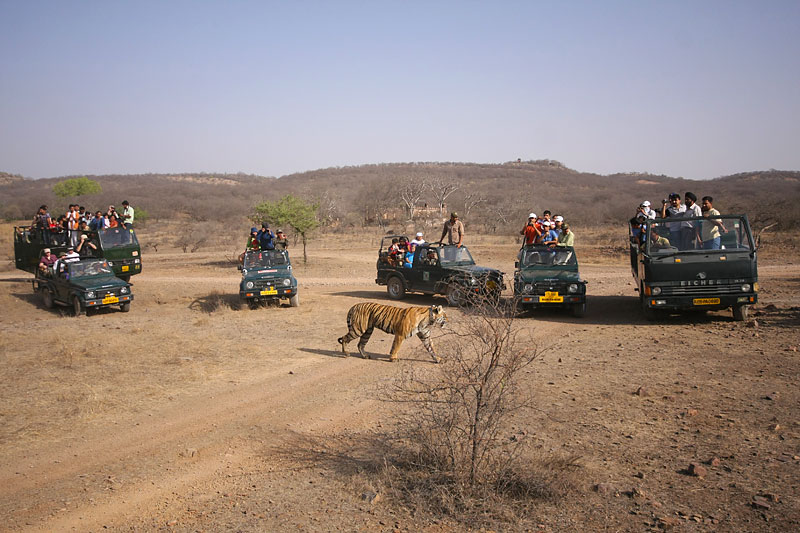Unregulated tourism in tiger reserves has created quite a furore of late, with even the Prime Minister Dr Man Mohan Singh writing to Chief Ministers of Uttarakhand and Madhya Pradesh cautioning against “unregulated and unplanned tourism,” following a report and media outcry on the negative impact of tourism on tigers and other wildlife on Corbett.
Resorts (along with other construction) is blocking critical tiger and elephant corridors, there is government infrastructure on crucial grasslands, too many vehicles enter parks, some flouting rules, racing, converging on tigers — some of us who visit tiger reserves are familiar with the mayhem. Such a situation exists in atleast ten of popular tiger reserves like Kanha, Bandipur, Bandhavgarh, Ranthambhore.
With a rap on the knuckle from the PMO, one would have thought that the states would proceed with caution. Well, think again. There is news that a fancy three-storey tourism lodge is being built in the heart of the Sundarbans Tiger Reserve not ten feet away from a sweet water pond frequented by tigers. The state hastens to assure that it is merely ‘redesigning’ the existing structure of the West Bengal Tourism Department. A nice play of words, given that an elaborate lodge is practically being rebuilt equipped with a generator with enough capacity to run air-conditioners. Great for tourists, but not for the tigers. Forest land has been excavated, weakening and uprooting mangroves, iron beams, nails, rubble lies piled up, and there is constant movement of labour. Once the ‘lodge’ is built the disturbance will be a constant, given that it stands almost atop one of the few sweet water sources in the mangrove forest. Crucially, a Supreme Court ruling forbids removing even a blade of grass from a sanctuary has been ignored. It is understood that no permission was sought from the centre before forestry land was diverted for a non-forestry purpose, as required by the Forest Conservation Act, 1980. How can the state allow for more disruption, when Sundarbans—reeling under anthropogenic pressure—is facing a severe conflict problem?
Meanwhile, Madhya Pradesh forest department has sought to give about four hectares of the buffer area of Kanha tiger reserve to the state tourism department to build a lodge. Ostensibly, the idea is to ‘phase out’ and shift tourism from the core critical tiger habitats where tourism facilities have sprawled—but whether this will really happen is a moot question.
For the record, I am not against tourism. If managed well and sustainably, tourism is the best way to win support in the conservation battle, and provide for livelihoods to the people around reserves, not when the benefits go to a few, and when it impinges on critical tiger habitats. My question is: barely one percent of India is allocated as tiger reserves, surely we can leave this much sacrosanct for the national animal, where tigers are priority.
However, it is not just tigers which suffer from such irrational tourism models. Innumerable instances come to mind, especially of charming hill stations and pristine beaches desecrated and devastated by monstrous hotels and ‘eco-resorts’ that usually break every law in the book. Currently what boggles the mind is “a Las Vegas in dry Gujarat”– a Rs 480-crore project at Khadir in the Rann of Kutch near the famous Dholavira ruins. It will reportedly have 18-hole world-class golf course, discotheques, theatre, spa, seven-star hotels, gambling. There are promises of ‘artificial beaches; and an artificial mechanism called Bay of Waves to provide the experience of sea coast” and a huge water body constructed for skiing and motor sports. The desert of the Rann will be exploited for jeep safaris. Modelled on Las Vegas, the zone is being dubbed as the ‘biggest watering hole of Gujarat’. I hate to break the party, but someone needs to point out that the project will destroy the mangroves, creeks, estuaries, mudflats, bets and desert that make up and support the remarkable and fragile ecology of Kutch which hosts a variety of migrant birds. Its unique and critically endangered wildlife include the wild ass, caracals, wolfs, bustards and has nesting colonies of rosy pelicans and flamingoes, of which the late and legendary ‘Bird Man’ of India Dr Salim Ali wrote extensively about.


 CI is a non-profit, non-commercial portal that aims to facilitate wildlife and nature conservation by providing reliable information and the tools needed to campaign effectively.
CI is a non-profit, non-commercial portal that aims to facilitate wildlife and nature conservation by providing reliable information and the tools needed to campaign effectively.